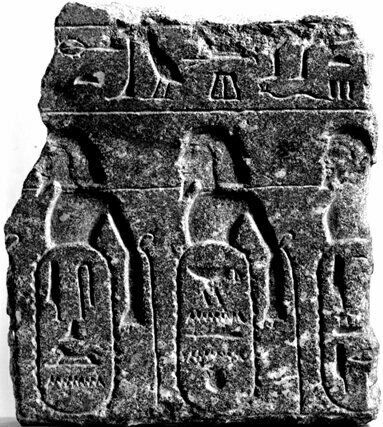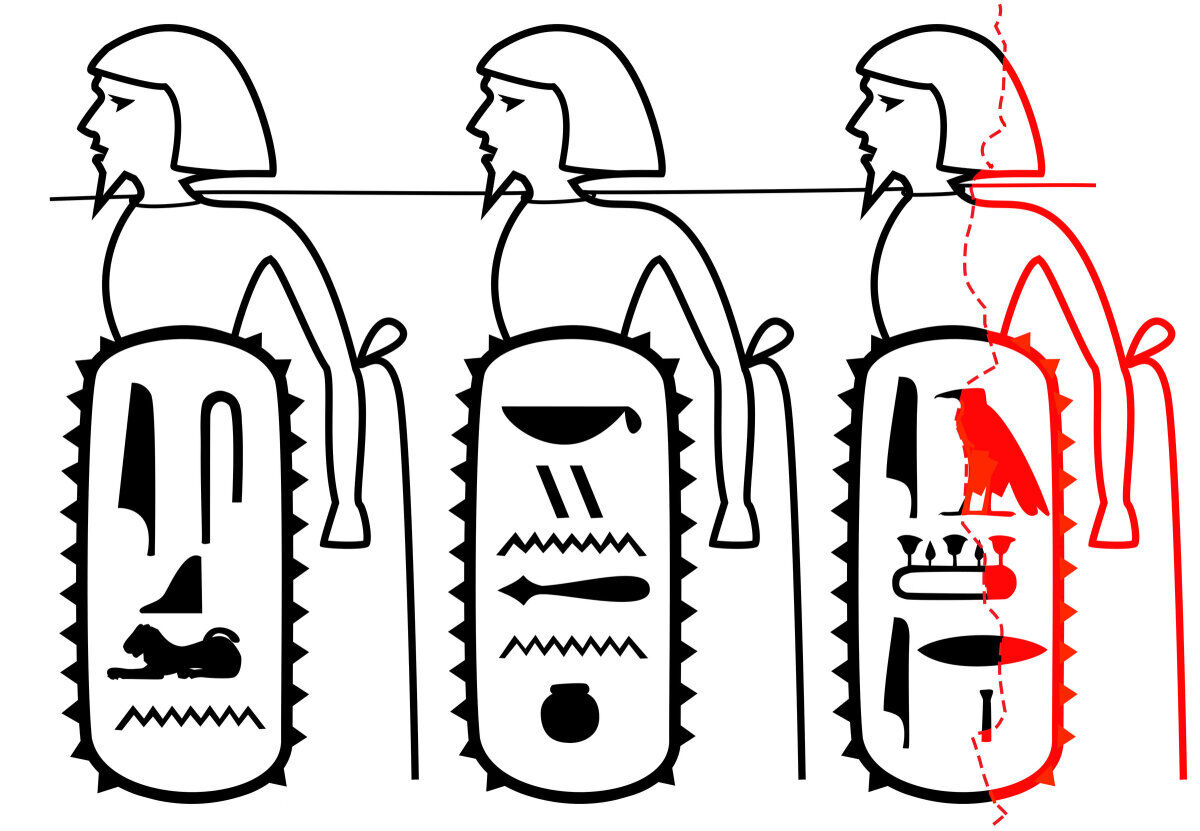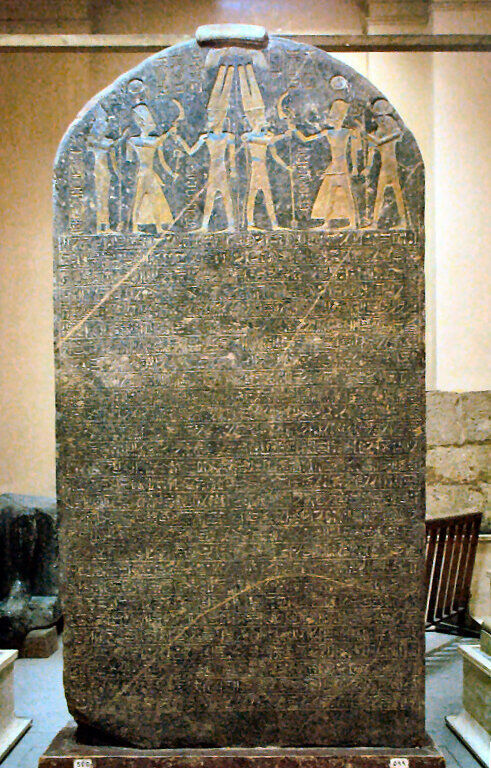The Merneptah Stele, also known as the Israel Stele, is well known for containing the earliest mention of the word “Israel” (c. 1207 b.c.e.). Actually, that’s not entirely accurate. It’s the earliest undisputed artifact containing the word Israel. There is another piece that may date up to two centuries earlier—only this one is fragmentary and is still technically classed as “disputed.”
In this article, we examine the fascinating artifact that purports to knock the Sir Petrie’s infamous Merneptah Stele off its throne—the Berlin Pedestal.
An Elusive Vulture
The Berlin Pedestal is a stone inscription acquired by Egyptologist Ludwig Borchardt from an Egyptian merchant in 1913. The piece, roughly 40 x 45 centimeters (15.75 x 17.72 inches), was probably part of a pedestal base. While the inscribed face is broken off at the edges, a sizable amount of imagery is preserved. Three captives are displayed, tied together at the neck, and depicted in the classic Egyptian West Asiatic form (a general depiction of Middle Easterners). Each prisoner has a corresponding “name ring,” labeling the country of origin for the prisoner, in hieroglyphic script.

The first ring on the left clearly reads “Ashkelon,” referring to the coastal city generally occupied by the Philistines as part of their Pentapolis. The middle ring clearly reads “Canaan.” The broken name ring on the right is the one in question. There has been some debate as to what the missing hieroglyphic letter in the upper right-hand portion of the ring is. One of the chief translators of the slab, Prof. Manfred Görg (who proposed the name Israel), believed it to be a vulture symbol, due to the preserved beak-like incision (Görg completed his research in 2001). Since that time, additional research has been done, including specially lit photography and 3D scanning. This has provided as-good-as-certain evidence that this hieroglyph is indeed the vulture—along with the beak, the left leg and claw is also apparent, as well as a belly outline. This, then, completes the full name ring. But that’s only the beginning of the debate.

Could It Be Israel?
With the vulture motif, the pure translation of this name ring is: I-3-Š3-I-R. This name is unique—it is not known, in this form, on any topographical lists. However, there is a real complexity to Egyptian spelling. The same hieroglyphs can sometimes represent entirely different sounds. “R” is also used to represent the sound “L.” (As a modern example: Many Chinese speakers confuse the sounds “R” and “L”—i.e., the city Rome/Roma, translated Luoma.) Due to their form in the word, the final hieroglyphs are best translated as an “L” sound, in representation of the Hebrew theophoric “El.” “3”, a glottal stop (with no English equivalent) can also be interchangeably translated as either “R” or “L.” Based on this, Görg, as well as later researchers Dr. Peter van der Veen and Dr. Christoffer Theis, concluded that the hieroglyphic name is best translated as: I-3-ŠR-I-L. The name, then, becomes clearly evident as “Israel.”
One of the strongest proofs that this is the correct and most logical translation is simply the other two names on the pedestal: Ashkelon and Canaan. Both of these territories are in the same general proximity, within the Promised Land. Thus, Israel is by far the best fit. And the Merneptah Stele provides further corroboration for this reading. Toward the end of this stele, we read the following:
Canaan has been plundered into every sort of woe:
Ashkelon has been overcome;
Gezer has been captured;
Yanoam is made nonexistent.
Israel is laid waste and his seed is not.

Here we have, in succession, the names Canaan, Ashkelon and Israel, grouped together due to regional proximity, in describing the Egyptian conquests. As such, it only makes sense to translate the Berlin Pedestal in the same way.
The weight of evidence supports the Berlin Pedestal’s translation as “Israel”—other proposed “rearrangements” of the word do not have supporting evidence. For a more in-depth look at the technicalities surrounding the inscription, here’s a thorough analysis by van der Veen and Theis.
But What Date?
As above, the Merneptah Stele dates to c. 1207 b.c.e. (Egypt’s 19th dynasty). The dating of the Berlin Pedestal is difficult to pin down (since it was not discovered in situ). Some have speculated that the pedestal dates to around the same time as the Merneptah Stele, primarily because it lists the names in a similar fashion. One such theory is that the pedestal was constructed around the time of Ramses ii’s reign (c. 1279–1213 b.c.e.—also due to some potential parallel iconographic features from his reign). However, there is another, perhaps far stronger method of dating this pedestal: the spelling.
The spelling for the regions on the Berlin Pedestal actually contains a fair number of differences to the Merneptah Stele. All three locations are spelled differently. (These kinds of differences are not unusual in the hieroglyphic transliteration of place names.) Based on the writing alone, the Berlin Pedestal actually resembles the spelling of the 18th dynasty—thus putting the Pedestal within a time frame of c. 1550–1290 b.c.e. More specifically, the writing closely parallels that of the early to middle 18th dynasty, around the time of Amenhoteps ii to iii (c. 1427–1351). If this is correct, then that places the “Israel” of the Berlin Pedestal up to as many as two centuries before Merneptah’s Israel. It is also possible that the names were inscribed onto the pedestal during a later period—again, closer to the reign of Ramses ii—but that these had been copied from an earlier list. Again, though, this still attests to the early nature of the regional names for them to be later copied in “archaic” form. Personally, I lean toward an earlier creation of the Pedestal—perhaps around 1300 b.c.e. or earlier. It strikes as unusual for the Egyptian scribe to carefully engrave more ancient forms of place names into the victory pedestal rather than using a more contemporary “vernacular.”

Of course, there are those who would propose a different translation—any translation—in order to get around accepting an early reference to Israel’s establishment within Canaan. Because according to them, Israel couldn’t have existed during this time period.
Significance
The significance of such an inscription is immediately clear. The Merneptah Stele already poses enough of a problem for scholars who argue a late Exodus and late establishment of Israel in the land of Canaan. The Berlin Pedestal helps provide evidence for Israel’s establishment in the land decades—if not centuries—before.
According to biblical chronology, Israel’s entry into Canaan would have taken place c. 1406 b.c.e. The Berlin Pedestal—as well as the Merneptah Stele—both fit well with this date, showing an early Israelite establishment in the Promised Land. The general scientific opinion, however, has been that Israel’s entry into the land did not occur until as late as the 1200s b.c.e. This is primarily due to the discovery of a number of cities having been destroyed during this time, as well as evidence of a cultural change in the region. (This destruction actually matches the biblical account of the Judges, which covers this time period. The theory also ignores evidence for violent conflagration in the 15th to 14th centuries b.c.e., at the time of the biblical Exodus. Further, the Bible actually provides evidence that full cultural change in the region did not occur until later on—e.g. Deuteronomy 6:10-11.)
Still others say there was no Exodus at all but instead merely an equally-late “uprising” from within Canaan, a sort-of “French Revolution” in which the working-class Canaanites rose up to overthrow their “bourgeois” masters and craft a new, glorious fictional history for themselves, now calling themselves “Israel.”
The Merneptah Stele provides contradictory evidence. It shows that by the 13th-century b.c.e., Israel was already a well-established nation in the Levant in order to be mentioned on the Stele. In fact, Israel must have been a readily recognizable and familiar nation in order to be mentioned in such a manner.
The Berlin Pedestal shows evidence of Israel’s establishment in the land perhaps as many as one or two centuries earlier. Further, the identification of Ashkelon as a separate entity to Canaan indicates the presence of a different people—the Philistines—living there. This is important, because the Philistines are generally considered by scholars to have moved into Canaan during the 1200s b.c.e. The Bible, however, shows that Philistines were living in the land as early as the time of Abraham.
Further, both this artifact and the Merneptah Stele prove that the Canaanites were still a separate and significant entity in the Holy Land at the same time as the Israelites, before the turn of the millennium. Some have mistaken the biblical account, thinking that the Israelites completely wiped out the Canaanites. In fact, the Bible affirms that just the opposite is true. Joshua 13:3 affirms that portions of the Promised Land were held by Israelites, by Ashkelonites, and by Canaanites—the three exact peoples directly paralleled on these artifacts!
Per usual, with the Merneptah Stele as well as the Berlin Pedestal, the biblical account is shown to be accurate, and the minimalists’ assessment untenable. It is the scholarly revisionists who are forced to continually revise their theories as the Bible continues to be vindicated, standing the test of time for millennia.
